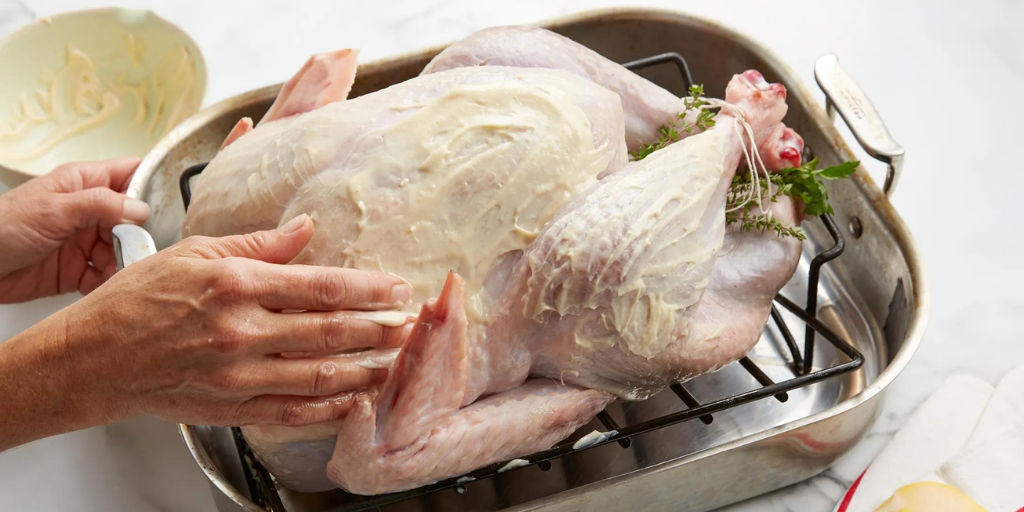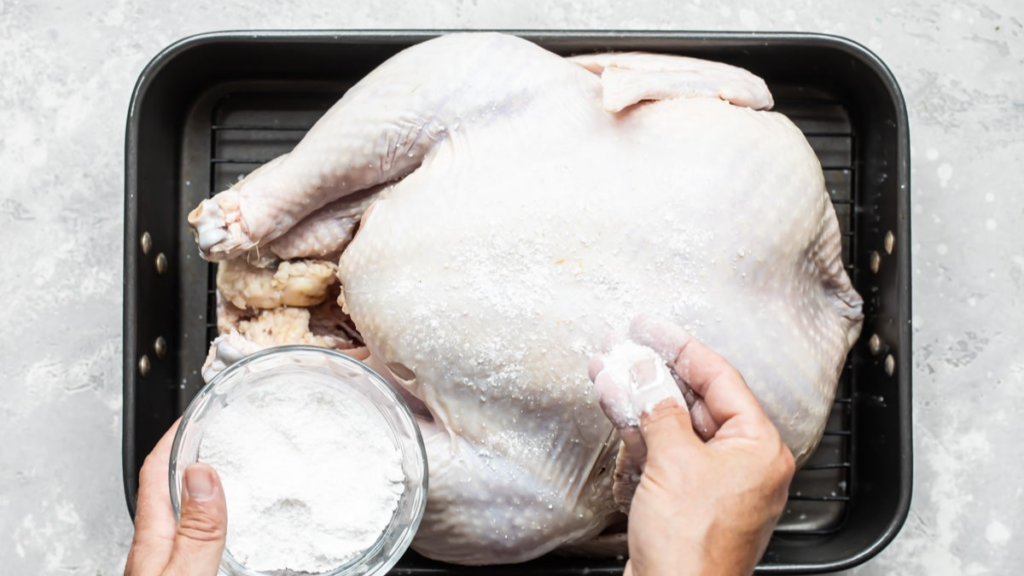A turkey may be kept frozen indefinitely, and bacteria there before freezing will develop anew as soon as it thaws. To figure out how long it will take to thaw a frozen turkey, all you need is some basic math—it’s the simple formula! First, determine how much turkey you’ll need per person based on their weight. Remember that to calculate thawing time, and you’ll need to know the weight of your turkey, so don’t tear off the label or remove the turkey from its package.
How Long Does It Take To Thaw Turkey?
A turkey may be kept frozen indefinitely, and bacteria there before freezing will develop anew as soon as it thaws. A turkey can be defrosted in three ways: in the refrigerator, in cold water, or a microwave oven.
Refrigerator Thawing
Your turkey should be thawed in the refrigerator, according to the USDA. This is the safest technique because the turkey will defrost at a steady, safe temperature. Allow one day for each 4 – 5 pounds of weight loss using this strategy. It will take around four days to defrost a 16-pound turkey. The turkey is safe for another two days after it has been thawed, so you can start thawing it six days before. The other two techniques (cold water and microwave) must be completed right before cooking the turkey, so you’ll have to wait until Thanksgiving morning to complete them.
Cold Water Thawing
Leave the turkey in its original wrapper and dunk it in a sink (or container) full of cold water for the cold water procedure. The water must be cold for the turkey to maintain a safe temperature. Every 30 minutes, you should change the water. Drain the water and replenish it with cold freshwater. Allow 30 minutes of defrosting time per pound when using this approach, so a 16-pound turkey will take 8 hours to thaw (starting about 4 a.m. if you want to eat in the afternoon!). Cook the turkey as soon as it has thawed.
Microwave Thawing
Check your owner’s handbook for the size of turkey that will fit in your microwave oven, the minutes per pound, and the power level to use for thawing a turkey before you commit to thawing it in the microwave. Remove the outer wrapping off the turkey and lay it on a microwave-safe dish to catch any juices that may spill. Use the weight-based defrost function. When thawing a turkey in the microwave, allow 6 minutes per pound as a general rule. During the thawing process, rotate it numerous times and even flip it.
If the turkey begins to cook rather than defrost, set it aside for 5 minutes before continuing to thaw. Cover the tips of the wings and drumsticks with a small piece of chicken foil halfway through thawing to protect them from the microwaves and prevent them from frying. It would help if you cooked the turkey as soon as it had thawed.
Can You Leave A Turkey Out To Thaw Overnight?
It would help if you did not do so. Although many of us have defrosted frozen chicken on the counter at some point, the answer is a resounding “no” when it comes to a complete turkey. And, in the case of the chicken, you’re not allowed to thaw it on the counter in the first place.
Meat that has been frozen thaws from the outside in. The outside of a turkey will thaw faster than the frozen middle if left to defrost on the counter, putting sections that reach the USDA “danger zone” temperature (anywhere between 40° and 140°F) at risk of bacteria formation.
Things start to get a little dicey around the two-hour mark. Remember, we’re talking about a 20-pound turkey that will take hours to thaw entirely if left out. Raw meat thawed at room temperature for two hours or more is susceptible to fast bacterial development.
Can You Cook A Frozen Turkey?
You can cook a frozen turkey. Yes, it sounds implausible, if not downright terrifying. But, despite all odds, it works. There’s still hope if you’re staring at a frozen turkey on Thanksgiving morning, wondering how you’ll get dinner on the table in a few hours. Without skipping a beat, here’s how to go from frozen to golden.
This method is as simple as it gets; I don’t have any tricks up my sleeve. We’re simply placing the frozen turkey on a roasting rack and placing it in a 325°F oven. Your turkey will take roughly 50 percent longer to cook from frozen than usual. A 14-pound frozen turkey, for example, will take around 5 3/4 hours to cook – see the chart below for more projected cooking times. A partially thawed turkey can also be cooked; the scheduled cooking times will be slightly shorter than for a frozen turkey.
As the turkey thaws, it begins to cook. Because the wings and drumsticks are minor and on the exterior of the turkey, they will cook quickly, whereas the large, thick muscle in the breast will take the longest. It also cooks from the outside in, so when you check the temperature while cooking, the flesh on the surface may be done, but the meat closer to the bone may still be cool. Check the turkey’s temperature in several areas and depths; when everything is above 165°F, it’s ready to eat.
With a frozen turkey, you won’t be able to do elaborate rubs, brines, or other days-ahead prep — you’ll have to keep things simple. Partway through cooking, when the outside of the turkey has thawed, brush it with butter (or another sauce!) and season it with salt, pepper, and any other spices you prefer.
What Are The Health Benefits Of Eating Turkey?
Here are some health benefits of eating turkey:
Rich In Protein
Turkey is a slice of lean meat that is lower in fat and higher in protein than chicken. It is a fantastic choice for people who want to cut down on their fat intake. However, because of the meat’s high protein and low-fat content, it cooks rapidly and becomes dry. To conserve moisture, various techniques, including brining, adding fattier ingredients, and jointing the bird for more even cooking, may be effective. Poultry meat protein is of ‘excellent quality,’ delivering all nine essential amino acids required for growth and repair and being a sort that human bodies can easily access and use.
Good Source Of B Vitamins
Turkey meat is a good source of B vitamins, such as B3, B6, and B12. These vitamins are required for energy synthesis, cognitive function, and red blood cell creation.
Good Source Of Minerals
Turkey meat is high in selenium, zinc, phosphorus, and iron, which helps to improve thyroid function, immunity, bone health, and energy production. Certain minerals, such as iron, are more abundant in darker pieces of meat, such as the leg and thigh.
Low In Fat
Poultry flesh, unsurprisingly, is high in “fast-twitch” muscle, which is used for brief bursts of energy like flapping the wings and scurrying away from predators. This is why bird flesh contains relatively little fat, with most of it concentrated in and just beneath the skin.
Fat is a vital part of a balanced diet because it keeps the meat moist, succulent, and flavorful. The fat in turkey flesh is unsaturated primarily, with only about a third of it being saturated. However, the quantity of fat in the bird would vary depending on how it was fed, with some plant-based meals favoring a more considerable polyunsaturated (omega-3 fatty acid) contribution.
May Support Heart Health
Turkey’s low-fat content, high protein content, and wide range of micronutrients are all reasons why it may be advantageous to your heart health. Higher diets of poultry and fish were linked to a decreased incidence of coronary artery disease in a large observational study of females. Furthermore, substituting a serving of poultry for red meat lowered cardiovascular risk by 19%.
Conclusion
The refrigerator is the best place to thaw your frozen turkey. It’s not the quickest option, but it’s the most secure. Allow the bird to thaw at a steady temperature below 40° for a few days. You can also thaw a frozen turkey in water, but remember that the cold water must be changed every 30 minutes to keep the turkey chilly and safe. Now that you know how to defrost a Thanksgiving turkey properly, you can focus on the numerous sides you’ll be providing. Here are some Thanksgiving cooking tips to help you stay on track!

